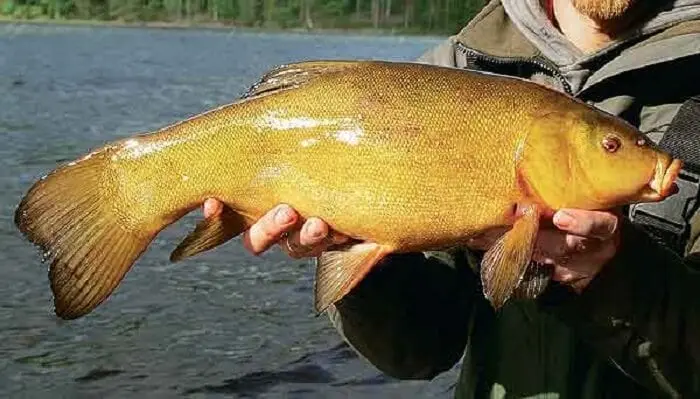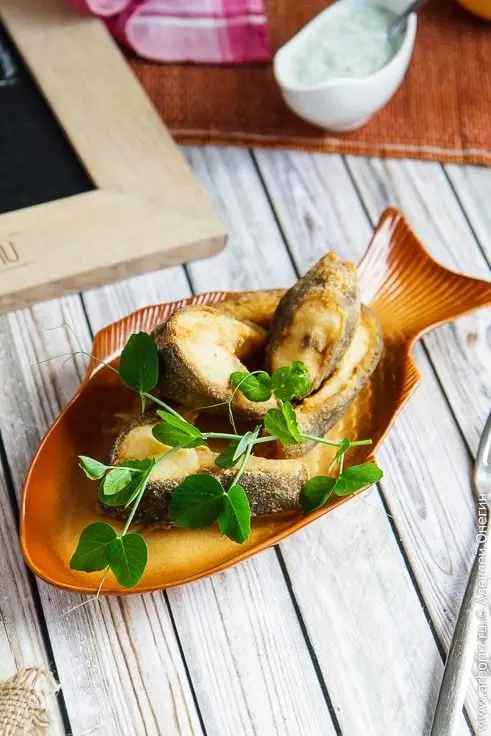Contents
Description of tench
Tench is a ray-finned fishe belonging to the order and the carp family. This is a beautiful fish, mostly colored dark green. But the color of the tench directly depends on the conditions where this fish lives. In river ponds with clear water, where a thin layer of silt covers the sandy bottom, the tench can have a light, almost silvery color with a greenish tint.
As for muddy ponds, lakes, and river bays with a thick layer of silt, the tench is dark green, sometimes brown. In forest peat lakes and some ponds, the green color of tench often has a golden hue. That is why there is such a term – the golden tench. Some people believe that tenches with a golden color were bred by selection. But more often, the color of the tench looks like old bronze.

What does it look like
The tench has a short and well-knit body. In some reservoirs, this fish is quite wide, and in river bays, the tenches are often somewhat run-down, elongated, and not as wide as in forest lakes. The scales of the tench are small, almost invisible, but You should clean them in the same way as in other fish of the carp family.
The tench scales are covered with a layer of thick mucus. After catching the tench, after some time, the scales change color, often in spots. The fins of this fish are relatively short, rounded, and soft. The tail fin is devoid of the traditional notch inherent in the tail fins of other carp fish and resembles a wide steering oar. Larger pelvic fins distinguish male tenches.
There are small tendrils on either side of the mouth. The eyes of the tench are red, which with its general appearance and golden coloration, makes this fish especially beautiful. In addition, the tench can be quite large. Recorded the fish heavier than eight kilograms. And now, in the reservoirs and forest lakes, specimens of more than seven kilograms weighing with a length of seventy centimeters come across.
Composition
The calorie content of tench is only 40 kcal. This makes it indispensable for dietary nutrition. Tench meat is easy to digest, and it quickly saturates the body. It can is one of the best varieties. The chemical composition of tench meat includes the following components:
- vitamins A, D, B1, B2, B6, E, B9, B12, C, PP;
- minerals S, Co, P, Mg, F, Ca, Se, Cu, Cr, K, Fe;
- polyunsaturated fatty acids.
- And also in the line are folic acid, choline and other substances necessary for the body.

Tench benefits
Tench meat is well suited for baby food, diet food and for the diet of the elderly. And besides this, it is good to improve visual acuity and to enhance metabolism.
- Vitamin B1 helps to improve the functioning of the heart and stabilizes the functions of the nervous system.
- PP will reduce blood cholesterol and help circulate oxygen throughout the body.
- Acids help break down fats, improve metabolism.
- The product will have a beneficial effect on the immune system, strengthen resistance to infections.
- The constituents of fish meat can regulate sugar levels and are antioxidants.
- Tench is useful for the endocrine system, for the normal functioning of the thyroid gland.
Harms
There are no special contraindications for the use of fresh tench fish, with the exception of individual intolerance to the food.
Cooking use

Tench has no industrial value. Almost always, meat has a persistent odor of mud, but despite this, it has a soft, pleasant taste and is very healthy.
On a note! The odor problem you may quickly resolve by adding spices to line dishes.
Tench fish is prized in the cuisines of European countries, where it is often boiled in milk in recipes. But you may cook tench in different ways. The most common way to cook tench is to roast or bake the carcass in the oven. It perfectly combines with any aromatic spices.
Before frying, sprinkle it with lemon juice and wait until it is soaked for 20 minutes, then rub it abundantly with spices (garlic, black pepper, etc.). Many people prefer pickled tench. According to the recipe: first, it is fried, and then, to the used oil, add vinegar boiled with spices (1/2 tbsp).
How to choose a tench
In order not to harm the body and cook high-quality fish, you need to know a few secrets:
- The first thing you should pay attention to is the appearance of the tench: the carcass must be intact without damage.
- The surface of the tench is clean, with a small amount of mucus.
- The carcass is elastic. When pressed with a finger, it should spring back and stay free of dents.
- Pay attention to the fish gills and smell. Fresh fish has clean gills, no mucus, and no rotten smell.
Tench with baked tomatoes and peppers

Ingredients
- fish fillet – 4 Pieces (250 g each)
- tomato – 4 Pieces
- sweet red peppers – 2 Pieces
- hot red peppers – 2 Pieces
- onion – 1 Piece
- garlic – 2 cloves
- sprig of basil – 1 Piece
- vegetable oil – 5 Art. spoons
- red wine vinegar – 2 Tbsp.
- spoons of arugula – 50 Grams
- salt,
- freshly ground black pepper – 1 Piece (to taste)
Servings: 4
Cooking steps
- Wash and dry tomatoes, hot and sweet peppers. Put the fruits on a baking sheet, sprinkle with 1 tbsp—vegetable oil.
- Put in an oven preheated to 200 C for 10 minutes.
- Turn once during cooking. Transfer vegetables to a bowl, cover tightly with cling film, and allow to cool. Then remove the skin from the tomatoes AND peppers, remove the core. Cut the pulp into large pieces.
- Peel, chop, and fry onions and garlic in 2 tablespoons. Heated oil, 6 min.
- Remove from heat, add chopped tomatoes and peppers, stir.
- Add vinegar and basil leaves to the mixture. Rub the fish fillets with salt and pepper, brush with the remaining oil. Fry the fish in a frying pan for 5 minutes. From each side.
- Wash the arugula, dry it, and put it on portioned plates.
- Place the tench fillet on top.
- Drizzle with cooked sauce.










Łi